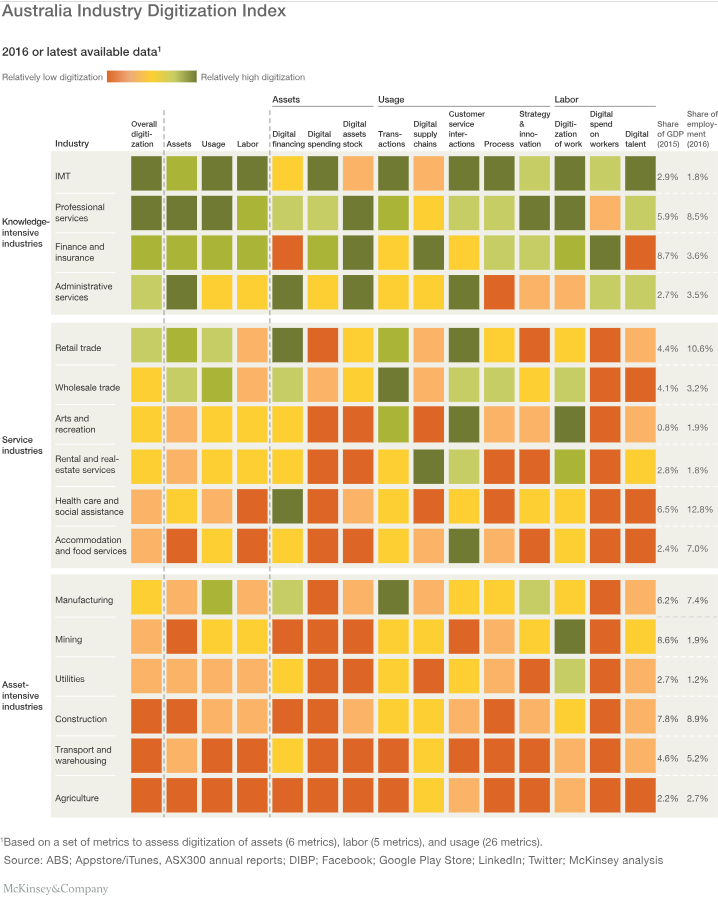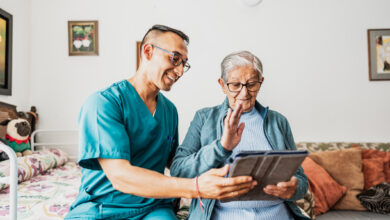Aged care needs an upgrade – and technology is the answer

It’s no secret that there’s a labour shortage in aged care.
Current projections estimate the industry is still short thousands of registered nurses and personal care workers.
By 2050, Australia will need an estimated 400,000 additional aged care and home care workers.
There are many ongoing efforts to close the gap and bolster the aged care workforce.
Normalised skilled migration levels, federal government initiatives such as A Life Changing A Life and improved pay – including the historic 15% pay rise that went into effect in July 2023 – all figure to aid in the recruitment and retention of care workers.
But will it be enough?
There are many ways to meet the needs of an ageing population. These ongoing efforts to increase the labour supply of healthcare staff is certainly one strategy, but it should not be the only one.
In economics, there’s a principle called Total Factor Productivity that measures how efficiently an economy converts inputs into outputs.
Essentially, it examines how effectively a business or industry can produce more of a product or service without having access to more resources, such as labour or capital.
Total Factor Productivity can improve through means such as workers gaining more experience, better management practices, and technological innovation.
In the case of aged care, technological innovation should be a bigger part of the answer going forward.
There are only so many people who will have the education, skills and desire needed to care for the elderly in the future.
We can’t rely exclusively on increasing the healthcare workforce.
Why companies don't invest in technology (and why they should)
Implementing new technologies takes time.
There is often a lag effect – the return on investment isn’t immediate, and transitioning from the 'old' to the "new" can be costly.
But, there’s also a great deal of comfort in familiarity.
Companies and entire industries tend to fixate on existing clients who are accustomed to doing business in a specific way; those established processes have worked well in the past, so they distract decision-makers from seeing the potential of new technologies and markets.
Video rental chain Blockbuster is an infamous example.
Blockbuster’s leadership was so invested in the traditional bricks-and-mortar model they failed to recognise the future of their own market, even as it sat right across the table from them.
Netflix entered the video-rental sector with a totally new concept – movies delivered by mail with no late fees on returns – and Blockbuster baulked at the idea, choosing instead to move forward with a dated, but familiar business model.
That refusal to innovate, of course, turned out to be Blockbuster’s death knell.
As it stands, the aged care sector in Australia does not have the luxury of taking a wait-and-see approach.
There’s a labour crisis happening right now, and projections for the coming years aren’t exactly encouraging. But technology can help improve that forecast.
Digitisation hasn’t reached aged care yet, and really, that’s not a surprise for a service industry that has relied so heavily on person-to-person interaction.
But other sectors across the country, such as finance and retail, have adopted technology to great success. They’ve altered how they engage with their customers, deliver their products, and assemble their workforces, which has driven growth and generated increased labour productivity.
A 2017 report examined digitisation in Australia and confirmed how far behind healthcare had fallen in terms of technological innovation; in fact, healthcare lagged alongside other long-established sectors such as manufacturing and mining.
The good news? It’s not beyond saving. From the report:
“By automating and simplifying processes, facilitating better connectivity, and using better reporting and advanced analytics, Australia’s annual healthcare expenditure could be reduced by 8 to 12 percent. Even more importantly, there is an opportunity to significantly improve the quality of care.”
Indeed, "technology", in our case, isn’t simply a reference to online presence or the latest gadget to hit the market.
More precisely, it’s about how we implement these modern tools to improve our analytics, streamline our processes, communicate more effectively, and ultimately reduce the burden and dependence on Australia’s aged care workforce.
How aged care could invest in technology
Let’s establish here that a commitment to technology does not mean replacing aged care workers with robots or artificial intelligence.
There is an irreplaceable human element to this work, and because of that, aged care and personal care actually provide a level of job security that other sectors can’t promise.
The big question is: How can we leverage technology around those face-to-face efforts in a way that allows the industry to thrive?
Truthfully, the labour shortage might always be something that needs to be fixed.
There might never be enough support workers to go around, especially as the elderly population continues to swell in the decades ahead.
In order to reduce the load on a workforce that’s perpetually stretched thin, aged care companies can utilise technologies to execute the most fundamental business functions.
For instance, at The CareSide, we built our own software to automate all administrative functions, effectively eliminating the need for large teams of back-office staff.
Our overhead costs are much lower than other providers, which allows us to reinvest those funds in other areas – such as hiring and retaining support for our aged care clients.
Put differently, our technology simultaneously reduces strain on the workforce while enabling our company to pump assets back into it – that’s a win-win.
Caregivers themselves also stand to gain quite a bit from an industry-wide adoption of technology – and not just in a monetary sense.
Back-office efficiency is great for business, but care workers on the front lines still have a job to do. They understandably gravitate to companies where they feel supported, and where they have access to the necessary tools.
Modern technology makes those tools more readily available, often through mobile platforms that allow carers to access everything they need from their phones.
Reliable scheduling, client communications, and digitised files such as forms, charts and checklists are conceivably just a finger-tap away instead of buried in mountains of paperwork.
At the end of the day, though, we’re all here to deliver the highest quality care to care recipients. That’s the whole point, after all.
Technology can undoubtedly improve employee experience and make administrative functions exponentially more efficient, but can it actually advance care and reduce Australia’s reliance on an overloaded workforce?
Here are just a few contemporary tools the aged care sector can implement to not only improve care but also gracefully navigate labour shortages and, ideally phase them out altogether:
- The Internet of Things (IoT): This network of devices and systems enables digital tools to communicate with each other without human intervention. IoT devices can be used to monitor care recipients – including vitals, activity levels, and medication management – and transmit data to healthcare providers in real-time. Around the world, companies like BGO Software are already taking a digital-first approach to healthcare; they’re not only normalising IoT care services, but they’re also building secure networks so data can be transmitted back and forth safely.
- Artificial Intelligence (AI): Systems powered by AI are now capable of analysing data, predicting health outcomes, and detecting abnormalities. They can also provide real-time data to help workers in our sector deliver care more efficiently and manage chronic conditions more effectively.
- Telehealth & Remote Monitoring Devices: Healthcare professionals don’t necessarily need to be in a room with someone to deliver care anymore. Telehealth relies on video conferencing and remote examination devices so doctors and care workers can communicate with and care for people from any distance. Technologies like these reduce the necessity of in-person visits and amplify our ability to deliver more care, with more efficacy, but without the need for more labour.
It goes without saying, but technology changes quickly.
There are numerous other innovations that the aged care sector could implement and benefit from instantly, but we have to start somewhere.
Adding more labour might always be part of the solution, but it can no longer be the entire solution.
Digitising our operations, automating many of our processes, and equipping our care professionals with the technology they need to work effectively and efficiently will, over time, reinvent aged care as we know it.
But it will also facilitate better service for care recipients across Australia, and ultimately, that should always be the goal.
Gareth Mahon is the co-founder and chief of The CareSide, a home care service provider. Prior to starting The CareSide, he worked as a technology executive at ANZ and KPMG.
Email: [email protected]







“Gareth Mahon is the co-founder and chief of The CareSide, a home care service provider. Prior to starting The CareSide, he worked as a technology executive at ANZ and KPMG.”
And this is where Aged Care is obviously headed & I tremble for the future care of the elderly. Having been a recipient of a HCP for nearly 7 years, I have witnessed the situation with staffing in real time.
Sure back room digital improvements are important, and easy to find information for workers can only improve their care duties.
I take issue with Telehealth being used in Aged Care unless it is necessary because of Covid, etc. Many have accepted satisfactory calls from their GPs, but would prefer face to face time.
I note the background of the writer of this article, and say that unless you have actually worked at the “coal face”, you have no idea of the intrinsic reality of what it takes to be a carer of the aged. Each elderly person is unique and cannot be put in the same box as everyone else. A well trained aged worker will look for those differences, and adopt a pattern of care that suits each person in their care.
I don’t know what it will take to train many more carers, but it’s not impossible to do, as long as we stop looking for digital answers instead of believing in people & their humanity.
Hi Helen, thanks for the feedback. This is Gareth from The CareSide. I’m the author of the article. I appreciate your perspective having been on the receiving side of care. I wanted to reply as I think these types of conversations are productive in helping push the industry forward, even if there isn’t always a consensus.
I can understand your point about the need for first-hand experience caring for an individual. That’s fair. My wife and co-founder, Emily, has more than 20 years of healthcare experience as a nurse and in various other positions at different organisations before starting The CareSide with me. In that regard, we balance each other out. We also have many talented and empathetic healthcare workers on staff whom I work with closely so I’m able to learn from them about the challenges of caring for the elderly.
I agree the sector needs to do a better job of attracting more workers. I also understand there’s a lot of scepticism now about technology with all the buzz about AI and automation. In my opinion, investing in technology and hiring more workers are not mutually exclusive. Technology can help empower carers so they can take care of patients more effectively. It can also reduce unseen costs that frequently go towards compliance and other overhead. Those savings can be passed back to consumers and invested in offering more training and advancement opportunities for healthcare workers. Ultimately, better pay and working conditions can help attract the people the industry desperately needs, and technology can play a role in that. Hopefully, that helps provide additional context on some of the ideas presented in the article. Thanks again for your feedback!
Hello Gareth
Thank you very much for responding to my concerns, and providing more information about your experience and those around you. I can see that you are genuine in improving the system that now exists within aged care, and I accept that you truly believe there is a better way to function.
I only know the HCP side of Aged Care, and know without any question that it is the Home Care Worker who is vital in following the guidelines of the Charter of Aged Care Rights. That’s why the worker must be well trained, and continues to be trained and kept up to date with methods of better care. However as we have a situation where there are not enough workers to ensure each client has the best care possible, it is currently just an aspiration. Spare a thought for the schedulers currently, and the mammoth task of finding someone to do a service. Whether the worker is suited to the client is no longer able to be considered.
Perhaps what you are endeavoring to do Gareth will take on board this aspect, and find a way to improve the care for consumers. Perhaps you are right – technology can be the answer. I wish you well.